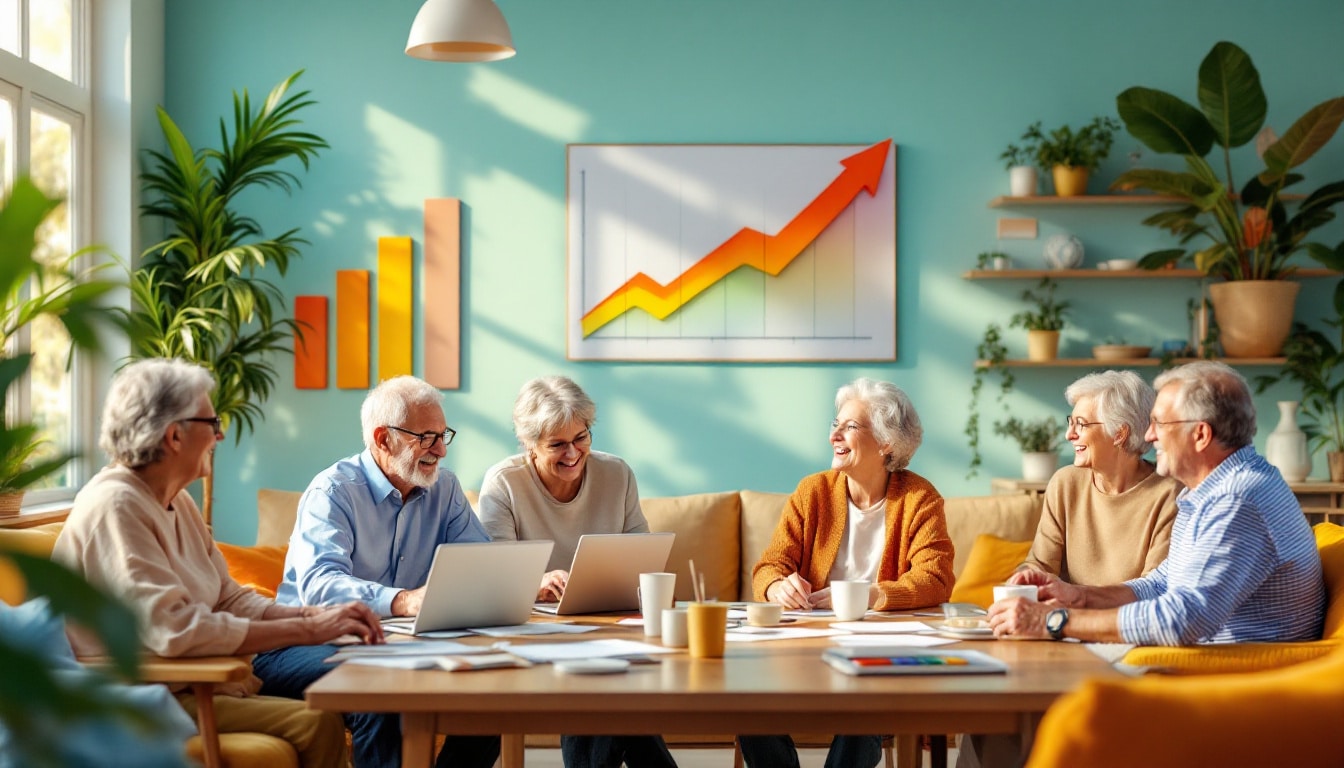Cookies and data play an essential role in our online experience. They allow us to provide and maintain quality services. Without them, browsing our site would be significantly less smooth.
These tools also help us to monitor interruptions and to protect our platform against spam, fraud, and abuse. By measuring audience engagement and site statistics, we better understand how our services are used and can thus improve their quality. If you choose to “Accept All”, we will use cookies to develop new services and customize content and ads based on your preferences. For those who prefer to limit cookie use, additional options are available to manage your privacy settings.

As the world faces unprecedented demographic aging, new economic opportunities are emerging, highlighting the immense potential of the silver economy. According to the IMF, this demographic transition can become a true economic asset if well exploited. Let’s explore the different facets of this trend and the prospects it offers.
Table des matières
ToggleWhat is the silver economy and why is it important?
The silver economy refers to all economic activities related to elderly people, generally those aged 60 and older. This segment of the population represents a growing share of society, leading to new demands and opportunities in various sectors. The importance of this economy lies in its ability to stimulate economic growth while addressing the specific needs of an aging population.
For example, the health, leisure, and assistive technology sectors are experiencing increased demand. Initiatives like those described in this article show how niche markets for seniors are rapidly developing, offering innovative products and services.
What are the main drivers of the silver economy?
Several factors contribute to the growth of the silver economy. Firstly, the increase in life expectancy means that elderly people are active longer, both professionally and personally. This translates into a greater demand for health services, leisure activities, and technologies that facilitate daily life.
Secondly, the purchasing power of seniors is on the rise, thanks to larger pensions and savings. This financial capacity allows for investments in specific sectors. Finally, urbanization and technological advances facilitate access to tailored services, as shown in this example from Hong Kong, where e-commerce and the silver economy come together to meet current challenges.
How does the silver economy influence the labor market?
The silver economy has a significant impact on the labor market. With an aging active population, companies must adapt by offering flexible working conditions and valuing the experience of older workers. Furthermore, new job opportunities are created in sectors dedicated to seniors, such as healthcare, home services, and assistive technologies.
This dynamic also fosters innovation in professional environments, encouraging intergenerational diversity and the integration of new skills. Studies show that companies that adopt an inclusive approach toward older workers benefit from better overall performance.
What are the challenges associated with the silver economy?
Despite its many advantages, the silver economy also presents challenges. One of the main obstacles is the need to rethink infrastructure to meet the needs of seniors. This includes building accessibility, adapted transportation, and specialized health services.
Another challenge is related to the training and continued education of older workers. It is essential to provide them with development opportunities so they can remain competitive in the labor market. Finally, intergenerational management within companies requires tailored strategies to harmonize the skills and expectations of different age groups.
What are the economic prospects of the silver economy according to the IMF?
The IMF recently published analyses highlighting the positive prospects of the silver economy. According to the IMF, this sector could significantly contribute to global economic growth by leveraging the skills and purchasing power of seniors. Investments in assistive technologies, infrastructure, and services dedicated to the elderly are considered promising growth levers.
Additionally, the IMF emphasizes the importance of public policies that promote the inclusion of seniors in the active economy. Initiatives aimed at encouraging flexible work, lifelong learning, and entrepreneurship among the elderly can enhance the economic impact of this demographic.
Which sectors benefit most from the silver economy?
Several sectors notably benefit from the silver economy. The health sector is expanding rapidly, with a growing demand for specialized services, advanced medical technologies, and home care solutions. The leisure and tourism industries are also seeing an increase in offerings tailored to the needs of seniors, providing personalized and comfortable experiences.
The technology sector plays a crucial role in developing tools that facilitate the daily lives of elderly individuals, such as health tracking devices, tele-assistance platforms, and simplified communication applications. Initiatives like those mentioned in this article illustrate how actions focused on demographic aging open new business opportunities.
How can companies adapt to the silver economy?
To fully leverage the silver economy, companies must adopt tailored strategies. This begins with a deep understanding of the needs and preferences of seniors, allowing for the development of relevant products and services. Adapting work environments to be more inclusive and accessible is also essential.
Investing in employee training to better meet the demands of older clients can improve service quality and enhance customer loyalty. Moreover, companies can explore new collaborations with organizations specializing in senior services, as demonstrated by this example, where strategic partnerships have led to the development of innovative solutions for the senior market.
What public policies support the silver economy?
Public policies play a crucial role in supporting the silver economy. Government initiatives aimed at encouraging the employment of seniors, funding research and development in assistive technologies, and promoting inclusive infrastructure are essential to maximize the potential of this demographic.
Moreover, programs for continuous training and tax incentives for companies investing in senior services can stimulate innovation and growth in this sector. Examples of best international practices show how well-designed policies can transform demographic challenges into economic opportunities, providing a model for other countries to follow.
What is the impact of the silver economy on innovation?
The silver economy stimulates innovation by creating demand for new and tailored solutions. Businesses are encouraged to develop smart technologies, personalized services, and ergonomic products to meet the specific needs of seniors. This quest for innovation leads to technological advances that benefit not only the elderly but society as a whole.
For instance, connected health devices and wellness applications are innovations directly influenced by the requirements of the silver economy. Furthermore, the emphasis on accessibility and ease of use pushes designers to create more intuitive and inclusive products, thus improving the user experience for everyone.
How does the silver economy influence sustainable development?
The silver economy can also contribute to sustainable development. By promoting healthier lifestyles and encouraging responsible consumption practices, this demographic can have a positive impact on the environment and society. Additionally, investments in green technologies and sustainable infrastructures for seniors promote environmentally respectful economic growth.
Companies engaged in the silver economy often adopt sustainable approaches, aiming to reduce their ecological footprint while meeting the needs of seniors. This includes the use of recyclable materials, waste reduction, and the promotion of energy-efficient solutions. Thus, the silver economy and sustainable development converge to create a beneficial synergy for all.
Merci @Lopinion_fr et Bravo également à Alogia et @VACbyC2S (coucou @Kelso3d ????) #bienviellir #ehpad #seniors #silvereco #merci https://t.co/yCMhnlLfFF
— AnSo (@AnSo_de_Geil) November 17, 2016








